article_detail
Semana Santa Sabado de Pasion Murcia
A personal view of the first Saturday of Semana Santa in Murcia capital
Semana Santa totally transforms the City of Murcia, which boasts a magnificent collection of sculptures, 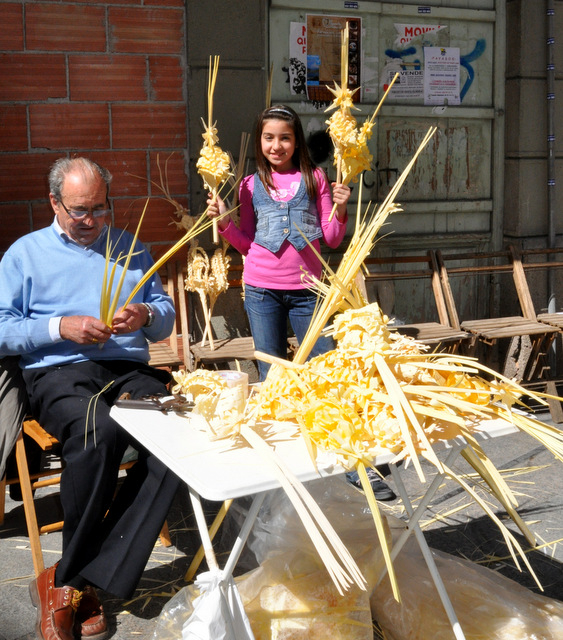 homed in a series of fine Baroque churches, a rich heritage complemented by a fascinating cultural tradition.
homed in a series of fine Baroque churches, a rich heritage complemented by a fascinating cultural tradition.
During Semana Santa the centric plazas of the city are abuzz with activity, the Cofradías preparing for their processions, thousands of flowers pouring into the churches as florists atop ladders create sweet scented banks of rustling velvets around their precious sculptures, capirotes and bags of sweets hang over the back of chairs as a last tapas is consumed to sustain the costaleros on their journey through the streets and the colours of penitents flow from one church to another as final preparations are made for the evening processions.
The weekend begins in Murcia, however, with the inelegant exit of Christ from the Church of San Francis de Asis, a newer church on the fringes of the city centre, which although is less dramatic than some of the larger 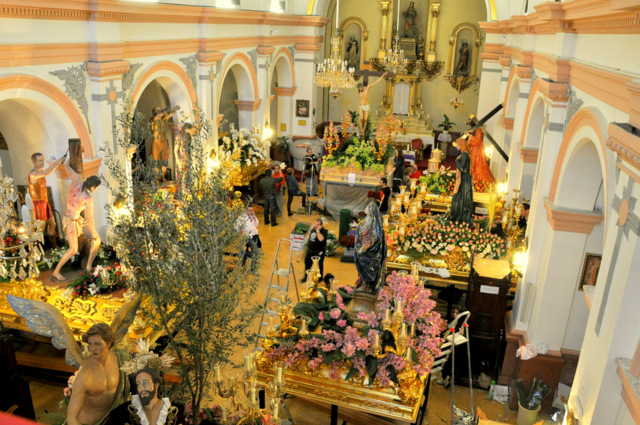 processions, was still an interesting experience.
processions, was still an interesting experience.
The morning began in Plaza Flores, where the vendors of palm ornaments sat weaving bleached palm branches into intricate decorations which would be carried on Palm Sunday when families donned their best 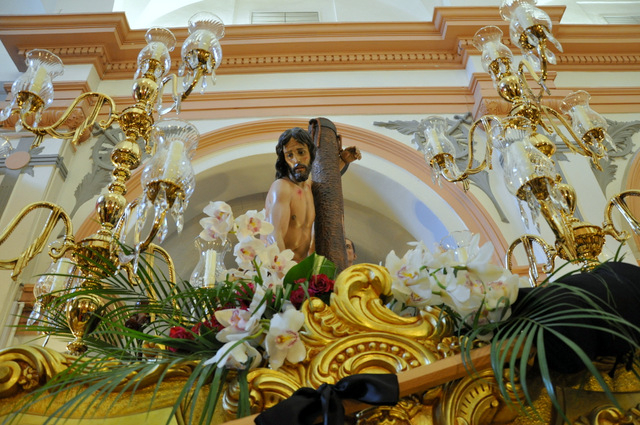 clothes to join in with the Palm Sunday services. Plaza Flores and the areas around it are key spots for the purchase of these mini works of art, which start at just a few euros each.
clothes to join in with the Palm Sunday services. Plaza Flores and the areas around it are key spots for the purchase of these mini works of art, which start at just a few euros each.
The plaza is one of the most atmospheric locations for a dish of tapas and is deservedly popular with the Murcianos themselves, fusing into the plaza of Santa Catalina containing a church of the same name.
Taking a chance we asked if we could see inside the church and were privileged to be admitted to watch work underway dressing the vast tronos ready for the evening procession. The sweet and penetrating odour of lilies combined with the tang of cut foliage as wires were bound to soft green stalks or unceremoniously plunged into the heart of yielding flowerheads, vast banks of flowers and foliage enveloping the sculptures. 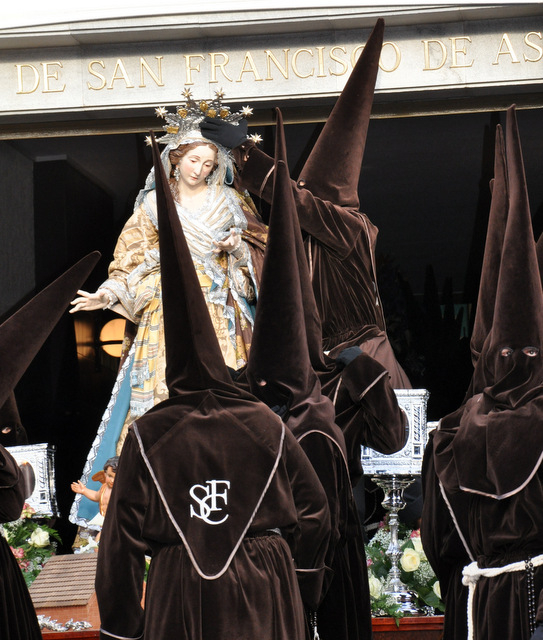 Some were dressed more simply with olive branches from the orchards and broad beans, a symbol of the fertility of the Murcian earth and the generosity of spirit with which Murcian penitents dispense food to the watching crowds: before the taste of the general public veered towards the boiled sweet, broad beans were a gratefully received supplement for those watching a parade file past for several hours.
Some were dressed more simply with olive branches from the orchards and broad beans, a symbol of the fertility of the Murcian earth and the generosity of spirit with which Murcian penitents dispense food to the watching crowds: before the taste of the general public veered towards the boiled sweet, broad beans were a gratefully received supplement for those watching a parade file past for several hours.
After a satisfying few dishes of tapas and an amble around the archaeological museum it was time for Jesus to make his first appearance from the contemporary church of San Francis.
This was actually quite a performance, beginning with an unexpected spot of drama as police towed away a vehicle which had elected to park right in front of the church exit door.
Finally the door of the church opened to disgorge brown velvet-clad drummers, their drums muffled with 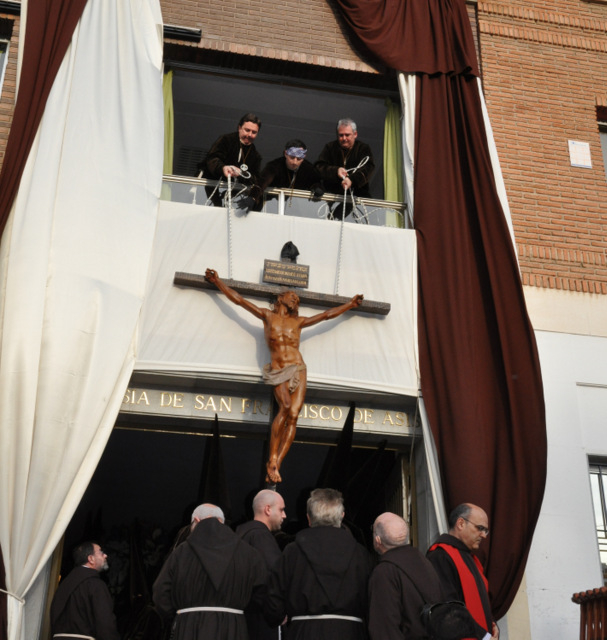 fabric.
fabric.
Silence fell and the mood changed.
A melodic, throbbing pulse, totally different to the insistent military ring of the drums of Cartagena, set the scene, creating heightened expectation. Then out came the Virgin Mary, inelegantly dragged out beneath the low metal doorway, crowned outside as her silver crown was too tall to fit through the door.
To cries of Vive la Virgen she was hoisted up and the throne disappeared off into the city, with the accompanying thump thump thump of the drums fading across the vast roundabout as she headed along the Alameda.
Finally out came the star of the show as the figure of Christ crucified was pushed out below the low doorway from inside the church, before being hauled into the air from the top window by practised hands in a swift 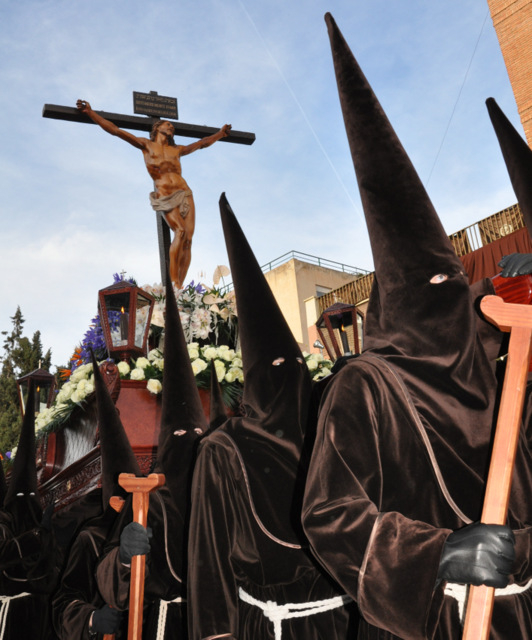 movement for just a few seconds as the throne emerged. To tumultuous applause he was slotted into place and hauled upright in a perfectly executed motion, drummers highlighting the moment for the appreciative audience who watched in admiration.
movement for just a few seconds as the throne emerged. To tumultuous applause he was slotted into place and hauled upright in a perfectly executed motion, drummers highlighting the moment for the appreciative audience who watched in admiration.
Then off he went into the narrow streets of the old city at a pace, accompanied by his velvet clad penitents.
The first weekend in the Murcia Semana Santa was underway.
Procesión de la Cofradía del Santísimo Cristo de la Fe
6pm, from the Iglesia de San Francisco de Asis, returning around 10.15pm
Click for Plaza Circular, Murcia
Route: Nuestra Señora de los Buenos Libros, Plaza Circular, Gran Vía de Alfonso X el Sabio, Plaza de Santo Domingo, Trapería, Plaza de Hernández Amores, Escultor Salzillo, Plaza del Cardenal Belluga, Frenería, Puxmarina, Sociedad, San Bartolomé, Esteve Mora, Calderón de la Barca, Santa Gertrudis, Fernández Ardavín, Pl Romea, Echegaray, Santa Clara, Enrique Villar, Santa Ana, Plaza de Santa Ana, Gran Vía Alfonso X el Sabio, Plaza Circular, Nuestra Señora de los Buenos Libros.
2 pasos and hermandades:
Santa María de los Ángeles. Pedro Arrúe, 2007
Santísimo Cristo de la Fe. Antonio Dorrego, 1954
This is then followed by:
Procesión de la Muy Ilustre y Venerable Cofradía del Santísimo Cristo de la Caridad
8pm
Muy Ilustre y Venerable Cofradía del Santísimo Cristo de la Caridad( Los Coloraos)Headquarters: Iglesia de Santa Catalina Departure 8pm, Return approximately 12.30am
Click for map, Plaza Flores
Route : Plaza de Santa Catalina, Plaza de las Flores, Plaza de San Pedro, Jara Carrillo, Glorieta, Arenal, Plaza del Cardenal Belluga, Escultor Salzillo, Plaza Hernández Amores, Trapería, Pl Santo Domingo, José Echegaray, Pl Romea, Fernández Ardavín, Santa Gertrudis, Calderón de la Barca, Esteve Mora, San Bartolomé, Sociedad, Puxmarina, Frenería, Conde Valle de San Juan, Jara Carrillo, Plaza de San Pedro, Plaza de las Flores, Plaza de Santa Catalina.
8 pasos
1. La Oración en el Huerto (1996) Sculptor: Arturo Serra Gómez.
2. La Flagelación (1998) Sculptor: Manuel Ardil Pagán.
3. La Coronación de Espinas (1997) Sculptor: Manuel Ardil Pagán.
4. Nuestro Señor Jesucristo Camino del Calvario (1999)
Sculptor: Manuel Ardil Pagán.
5. Santa Mujer Verónica (2003) Sculptor: José Hernández Navarro.
6. San Juan (2001) Sculptor: Manuel Ardil Pagán.
7. María Dolorosa (1735) Sculptor: Francisco Salzillo.
8. Santísimo Cristo de la Caridad (1994) Sculptor: Rafael Roses Ribadavia
article_detail
Contact Spanish News Today: Editorial 966 260 896 /
Office 968 018 268













